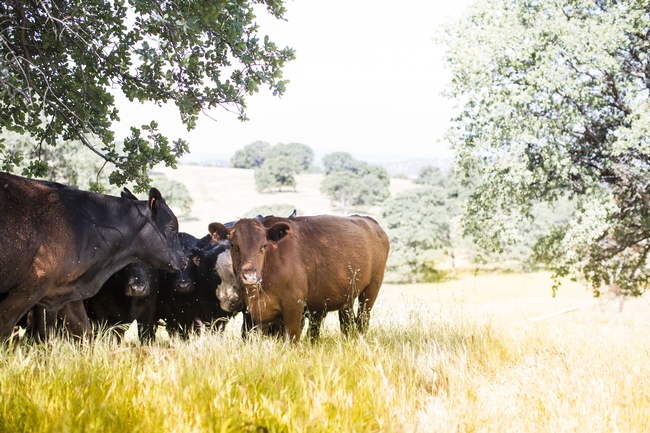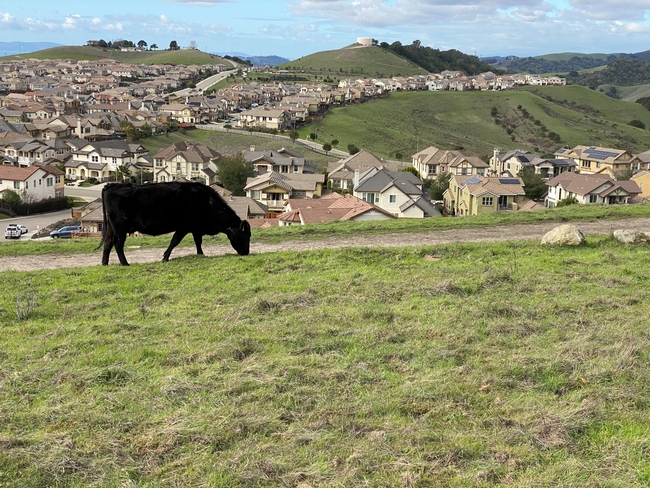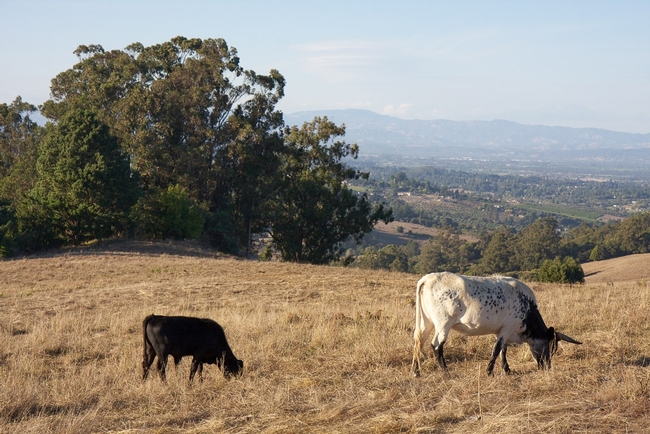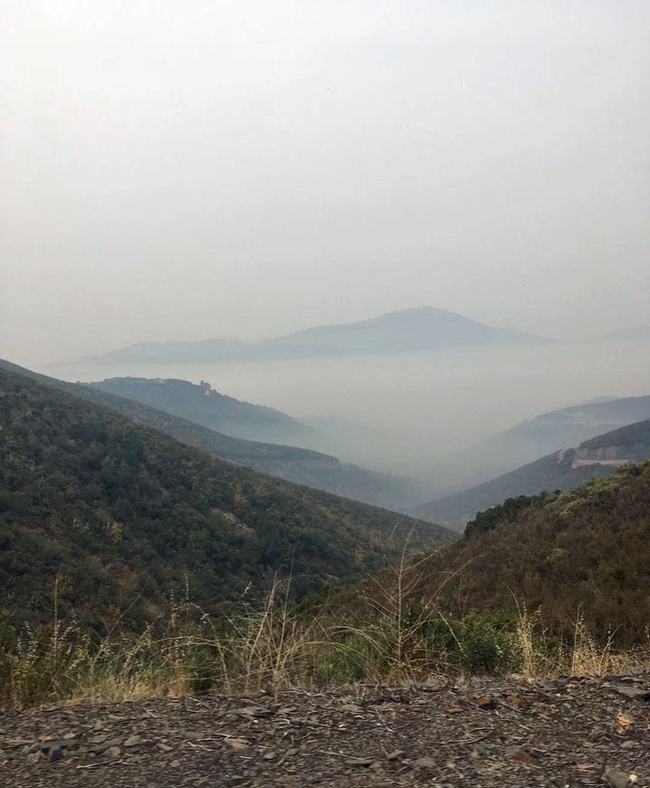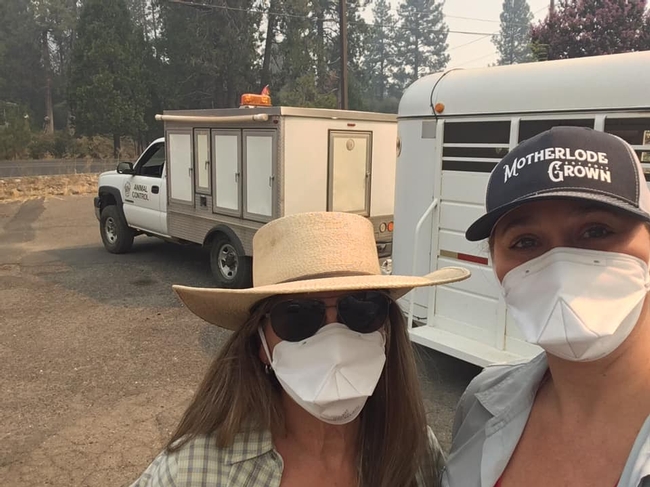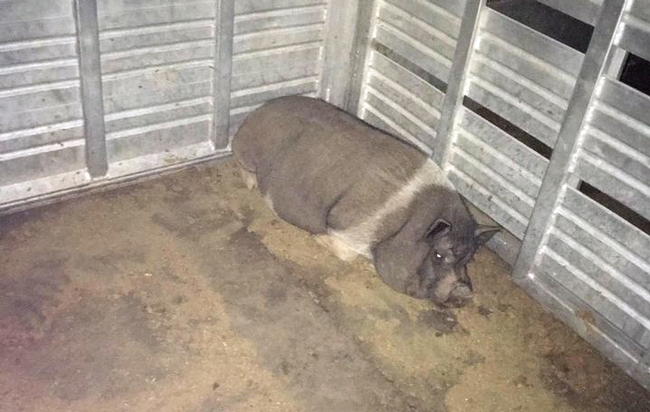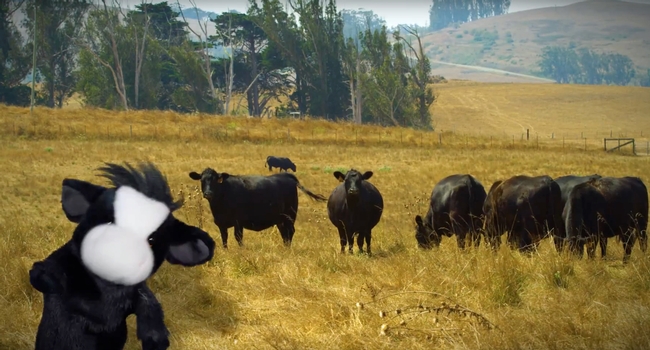Posts Tagged: Sheila Barry
Fighting fire with feeding
Are cattle a secret weapon for taking on California wildfires?
California's cattle ranchers contribute a significant amount to the region's culture, economy and food supply, but do they also inadvertently help to temper the wildfires that have been plaguing the state? And if so, is it a better alternative – environmentally speaking – to letting grasslands burn?
A new study published in the journal Sustainability delves into the topic, weighing the advantages – and disadvantages – grazing cattle bring to the table. Researchers, including scientists from University of California, Davis and UC Agriculture and Natural Resources, set out to calculate the greenhouse gas emissions of cows consuming vegetation that would otherwise burn in wildfires. Then they estimated the GHG emissions that would result should that forage be untouched and therefore, consumed by fire, eventually comparing the two.
Feeling the burn
Given the severity of California's recent wildfires and the belief they will continue and even escalate in the near future, it's a discussion worth having, said Frank Mitloehner, an expert in animal agriculture and air quality from UC Davis, director of the CLEAR Center and one of the researchers who contributed to the peer-reviewed article.
“Each year from 2010 to 2020, California lost on average 89,000 acres of grassland to wildfires,” said Mitloehner, who is also a Cooperative Extension specialist. “In addition to the obvious disruption and devastation they caused, the fires spewed greenhouse gases and harmful particulate matter such as black carbon into the air and into our atmosphere. Those alone threaten climate health and human well-being.”
A fast and furious gas
Cattle are adept at eliminating herbaceous fuel as they graze. However, at the same time, their specialized digestive system produces methane that is expelled most often in the form of enteric emissions … more commonly known as belches. By way of background, methane is a potent greenhouse gas that warms the atmosphere at 25 times the rate of carbon dioxide over 100 years. But it's only in the atmosphere for 10 to 12 years after it's emitted. Following that, it's broken down into carbon dioxide and water vapor.
For that reason, Mitloehner refers to methane as a “fast and furious” gas. Furious because it warms with a vengeance and fast because it does so for only a short time, especially when compared to carbon dioxide. Furthermore, because of the biogenic carbon cycle, whereby plants extract carbon dioxide from the atmosphere for photosynthesis, the warming of methane and its byproducts can end entirely when it's hydrolyzed and used by plants.
How researchers calculated emissions
In order to determine if grazing, methane-emitting cattle are better for the atmosphere than burning grasslands, Mitloehner and the other researchers employed a method known as “Monte Carlo simulation,” a mathematical technique used by scientists to predict outcomes of an uncertain event.
Looking exclusively at methane emissions, they found it's better to have cows eat vegetation than to have wildfires burn it. Granted, it's only marginally better, but when one considers other advantages of animal agriculture and conversely, other disadvantages of widespread, uncontrolled fire, the conversation suddenly shifts.
“Even if cattle provided no other benefit to us, which certainly is not true, we can now make the case that they are helpful to us in yet another way,” Mitloehner said.
Friends or foes?
It goes without saying that one would be hard pressed to find much good to say about wildfires, but that doesn't hold true for animal agriculture. The industry provides jobs and supports the economy in other ways as well. Plus, it is a major source of protein-rich food that is in increasing demand as the world's population continues on a trajectory toward 10 billion people by the year 2050.
Where global warming is concerned, the industry is in the unique position of being able to reach net-zero warming, also known as climate neutrality, if it continues to aggressively chip away at its methane emissions, which Mitloehner asserts is of critical importance to the planet. “Few other sectors can reduce its warming to net zero and still be of service to society, but agriculture can because of the way methane behaves in the atmosphere,” he says.
To be clear, grazing cows are no match for wildfires. Yet, in addition to everything else the sector does for us, slowing the burn and keeping relatively more methane from entering the atmosphere are not nothing.
In addition to Mitloehner, authors of the study are Cooperative Extension advisors Sheila Barry, Devii Rao and Theresa Becchetti; Rowan Peterson, Ermias Kebreab and Minju Jung of UC Davis; and Felix Ratcliff and Kaveh Motamed of LD Ford.
This article was first published on the website of the CLEAR (Clarity and Leadership for Environmental Awareness and Research) Center at UC Davis.
New UC ANR publication educates public on cycles of cattle production, grazing and economics
The pandemic has brought more people into nearby parks and public lands for hiking, biking and other recreational activities. In areas like the East Bay Regional Parks – a San Francisco Bay Area park system totaling more than 120,000 acres where about 65% of the land is grazed by livestock – visitors might see goats, sheep and, most likely, cattle.
Those encounters with animals (or their manure) represent a prime opportunity for members of the public to learn about agriculture and the ecological benefits of rangelands, according to Larry Forero, a UC Cooperative Extension livestock and natural resources advisor.
As livestock grazing (mostly by beef cattle) constitutes a significant portion of land use across the state, Forero – along with fellow UCCE advisors Sheila Barry and Stephanie Larson – recently authored a UC Agriculture and Natural Resources publication summarizing the mechanics of cattle production.
“Beef Cattle on California Annual Grasslands: Production Cycle and Economics,” published in October and available as a free download on the UC ANR Catalog, describes the seasonal phases of cattle production and the factors that impact ranchers' financial calculations and management decisions.
“This concise publication walks through annual stock flows and calendar of operations and gives tables for estimating costs, return over cash, and gross income under various scenarios,” said Forero.
“Even if only a relatively small percentage of park goers are interested, you still touch a lot of people with a document like this,” Forero explained.
He said he hopes park signage and QR codes will direct visitors to the publication for more information about the cattle and their seasonal movements.
“People often wonder where the cattle go when they leave the park and when they will return,” co-author Sheila Barry said. “The cattle may go to grass or feed yards in other places in California or even out of state.”
But, as this new UC ANR publication explains, the cattle production cycle turns over anew.
“There will be more cattle next fall, I promise,” Barry said.
Cattle grazing is a tool for reducing fire danger
Cattle can help reduce wildfire danger by grazing on fine fuels in rangeland and forest landscapes, reported Sierra Dawn McClain in Capital Press. The article also appeared in the Blue Mountain Eagle, the Westerner and the East Oregonian.
The article cited the preliminary results of research by UC Cooperative Extension that show that cattle consumed approximately 12.4 billion pounds of forage across California in 2017. The researchers believe the cattle could do more.
Many grazable acres aren't grazed, said Sheila Barry, UCCE livestock and natural resources advisor in Santa Clara, San Mateo, Alameda and Contra Costa counties. According to the Capital Press article, Barry said the public doesn't always recognize the benefits of grazing; they see short grass and cow patties. Cattle's role in preventing wildfires is often overlooked.
Devii Rao, UCCE livestock and natural resources advisor for San Benito, Monterey and Santa Cruz counties and the study's lead, said ranchers should target grazing around homes, infrastructure, roadsides and at the wildland-urban interface.
“There are so many things we can do better. Cattle grazing is really important to fire safety, and it's time we have more conversations about it,” Rao said.
UC Cooperative Extension springs into action to aid wildfire recovery
After the destructive LNU Complex Fire burned through farms and ranches where Morgan Doran lives and works, he immediately volunteered to help families and local authorities take care of animal victims.
Doran, the UC Cooperative Extension livestock and natural resources advisor for Yolo, Napa, Solano and Sacramento counties, spent two full days the weekend of Aug. 22-23 in a truck with a county sheriff's deputy escort to search for live animals and provide information on how to handle dead livestock.
Nearly 300 animals – mainly horses, sheep, goats and alpacas – were killed during the LNU Complex Fire in Solano County. Some were hit by vehicles, others couldn't escape burning buildings.
“I helped locate animals that needed attention and shared burial and other disposal options and guidelines,” Doran said. He also created an online survey for dead or missing animal reporting.
Doran, also the director of UC Cooperative Extension in Sacramento, Solano and Yolo counties, and his staff and partner organizations – including the USDA Farm Service Agency, Natural Resources Conservation Districts, local resource conservation districts and county officials – have organized a free webinar to help local residents in fire recovery. The webinar is from 9 a.m. to 12:30 p.m. Thursday, Sept. 10. Pre-registration is required.
Topics to be covered are:
- Navigating the agency alphabet soup for disaster assistance
- Understanding wildland fire impacts
- Impact of fire on oak woodlands, what to expect and what to do
- Impact of fire on rangelands, what to expect and what to do
- Impact of fire on orchard trees, what to expect and what to do
- Impact of fire on vineyards and wine grapes, what to expect and what to do
- Erosion risks and mitigation measures
- USDA disaster programs and how to apply
Evacuating animals
In areas where the Moc Fire burned near Moccasin, Calif., UC Cooperative Extension 4-H advisor in the Central Sierra, JoLynn Miller, joined partners to activate Team ELITE (Evacuation of Livestock in Tuolumne Emergencies) so trained volunteers could help move animals to safety and ensure they are fed and housed during the wildfire.
The organization was established in the wake of the 2015 Butte Fire, when officials recognized the need for coordinated animal evacuation planning. They drafted Miller, an experienced horsewoman and community volunteer, to spearhead the group.
“We work closely with and are dispatched by animal control during an emergency,” Miller said. “Team ELITE requires members to be trained in incident command systems and they are sworn Disaster Service Workers once they complete a Team ELITE orientation and training. The Moc Fire was the first fire where we've done evacuations.”
Team ELITE was placed on standby on Aug. 20. A few hours later, three teams were behind the fire lines.
“Volunteers worked throughout the night to pick up animals,” Miller said. “The first night we had donkeys, chickens, horses, alpacas and pigs evacuated.” The animals were held at the Mother Lode Fairgrounds in Tuolumne County.
The team spent three days, Aug. 22-24, feeding and watering animals. Aug. 25 the evacuation orders were lifted and they helped families get their animals back home.
For more information about Team ELITE, see its Facebook page https://www.facebook.com/TeamELITEinformation/
Valuing the losses
Federal, county, CALFIRE and other officials routinely turn to UCCE experts to gather information about the impact of wildfire on agricultural lands.
Two UC Cooperative Extension rangeland advisors, Theresa Becchetti of Stanislaus and San Joaquin counties and Sheila Barry of San Mateo, Alameda, Santa Clara and Contra Costa counties, both cover areas burned by the SCU Fire.
In order for a disaster to be declared and for insurance payouts, a value must be attached to losses caused by the wildfire. In rangeland areas, components of the losses include hundreds of miles of fencing, forage, stock ponds and damage to the soil and seedbank that could impede grass growth for years. Livestock may also be lost in wildfires.
“In some respects, the SCU Fire was an invisible fire because it didn't threaten vineyards or redwoods – landscapes that get more attention. It is grassland, oak woodland and brushland. Some very small pockets of forest,” Barry said. “But it is actually the second largest fire in the state's history.”
Becchetti had previously developed a methodology for calculating forage losses. The two scientists were able to use the system for establishing the economic loss to ranchers and government agencies caused by the blaze. CALFIRE also used the information to inform the distribution of its firefighting resources.
“The Farm Service Agency has told us that the information we put together on the value of the area is enough for the local county committees to declare a disaster, which will release emergency cost share programs,” Becchetti said. “We are continuing conversations with the agencies in the four counties and starting to put information out for ranchers.”
UCCE will host meetings regarding fire recovery and disaster assistance programs. Visit local UC Cooperative Extension websites for details.
Videos show hikers how to avoid Black Friday stampedes on park trails
While Americans traditionally beat a path to the malls the day after Thanksgiving, many opt out of shopping on Black Friday to enjoy the outdoors. In regional parks and other open spaces, hikers may encounter crowds of a different sort – cattle grazing with their calves. A 1,200-pound cow blocking the path can be daunting.
With a little patience and understanding, people who hike, bike and horseback ride can coexist peacefully with the cattle, according to Sheila Barry, UC Cooperative Extension livestock and natural resources advisor in Santa Clara County.
For happier trails, UC Agriculture and Natural Resources has produced a series of videos that show hikers how they can amicably share open space with their beefy neighbors. In a two-minute video, a black cow puppet with a furry white face describes how to politely coax cows to moo-ove aside without spurring a Black Friday stampede.
“We wanted to produce videos that are entertaining as well as informative,” Barry said.
The cow pun-filled video also describes the ecosystem services cattle provide by consuming nearly their body weight in plants. By grazing, cows manage the vegetation, reducing wildfire fuel, increasing water capture and promoting the diversity of native grasses and wildflowers.
In “Sharing open spaces with livestock,” the UC Agriculture and Natural Resources livestock experts give four simple tips for safely sharing open space with cows on the trail:
- Keep moo-ving and speak in a normal tone. Sudden movements and loud noises may surprise cows.
- Approach cows from the side or front. They find it udderly unnerving to have someone sneak up from behind, the bovine blind spot.
- Steer clear of getting between a protective mother and her calf.
- If you need to move a cow, step slowly into its flight zone. Invading the animal's “personal space” will motivate it to mosey aside.
A second video, “Sharing open spaces with livestock when you have a dog,” gives advice for dog owners to keep their best friends safe around cows.
In a third video, “A year in the life of a cow,” the UC Cooperative Extension spokespuppet describes a typical year for a beef cow.
“The videos are a fun way to educate the public about grazing on rangelands,” said Stephanie Larson, UC Cooperative Extension livestock and rangeland advisor in Sonoma County.
The videos are based on the UC ANR publication “Understanding Working Rangelands,” authored by Barry and Larson, at http://ucanr.edu/shareopenspace.
Watch all three videos on UC ANR's YouTube channel:
Sharing open spaces with livestock https://youtu.be/Qd8LEGLDhaM
Sharing open spaces with livestock when you have a dog https://youtu.be/zzdGnfFwmcA
A year in the life of a cow https://youtu.be/znJbWknVXVg

